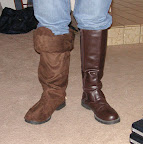This is my second journal entry about my endeavor to create a Legend of Zelda: Twilight Princess Link costume. In this one I’ll be talking about some details of the tunic and hat and show some photos of some parts that have been finished.
First let me apologize for the poor quality of my photographs. I am not a very good photographer! I hope to include much more detailed photos at a later time with detailed specs of what I did. Right now I’m keeping things a little bit general. I may make a more official tutorial at a later time.
You can find all of the photos for the making of my Link costume at my Picasa Web album:
http://picasaweb.google.com/bogusred/LinkCostumeTheMakingOf
Reference
During the course of making this costume I referenced the official artwork of Link from Twilight Princess as well as looking at what otherCosplayers did for making this same costume. I mostly referenced Pikmin Link because she is the best of the best. I think she made a lot of smart decisions. At the same time, I tried not to make mine exactly like hers but I did borrow a few of her ideas. I encourage you to check outcosplayers.com and do a search for the character you are trying to cosplay to see how others solve the same problems that you are facing. You’ll learn from what others both what does and does not work just by seeing their photos.
Do not become a Slave to your reference!
Sometimes as an artist I have had the horrible experience of becoming a slave to my reference. I see that my reference material looks awesome and try my hardest to mimic exactly what I see which usually ends up being a bad thing in the drawing world. When working from photographic reference and translating to art you don’t want to do that because you end up not doing any creative expression of what you are seeing. Also you end up becoming paralyzed by the shear amount of information before you. Instead we should try to improve what we see, not mimic it. It is something that I experienced when I first started studying figure drawing.
I experienced the same problem when I started this costume. I started to become so obsessed with Pikmin Link’s creation that I became disheartened. I was frustrated because I couldn’t find the right fabric that was exactly the same as hers. I was frustrated that I knew I wouldn’t be able to create something as great as her costume. But I finally realized that I shouldn’t try and recreate hers. But instead try to create my own interpretation of Link. Not try and duplicate what someone else did because there’s no creativity in that. I hope you don’t find yourself in that same situation. Come up with your own creative ways to make cosplay, but at the same time, learn from the trial and error of others.
Time constraint, no shortcuts
I also became frustrated by the amount of items needed for this costume. Not only the tunic and hat but pants, an under shirt, gloves, boots, chain mail, the list goes on. How the heck am I going to get it all done in two months intime for Halloween? But I decided I was just going to take it one item at a time. Otherwise I end up becoming overwhelmed by the sheer amount of work before me and never get anything done (which did happen to me a few times in the past couple weeks). I’m just going to get as much done as possible before halloween. But without rushing the creation of items. I’m not going to do a rush shitty job on a piece just because I want it in time for halloween. rather, i want to get done what I can now and then continue to work on it afterward to have it ready to wear at an anime convention. And I’m going to do things right. Not take shortcuts!
Anyway, on to the details…
Muslin prototype
I learned this technique of doing Muslin prototypes from a couple of professional costume makers called The Stitchin’ Babes. Back in 2001 they did a couple of workshops at Fanime explaining their techniques for how they make costumes and one of the things they do is when they don’t have a pattern for a particular piece of clothing for the costume, they mock it up in Muslin, try it on their manikin, and then make adjustments until it fits right. Then when the prototype is fitting and working, they tear apart the muslin prototype and use those pieces as pattern pieces. For those that don’t know, Muslin is a cheap white woven cotton fabric you can get from any fabric store for something like $1 a yard. It doesn’t stretch a whole lot so if you can fit into your muslin prototype, you should be able to fit into your finished one just fine.
A few years ago I had made a Red Link costume from The Legend of Zelda: Ocarina of Time. When I made that costume I made a Muslin template for the tunic and hat. I used these templates as a starting point for my new tunic. I didn’t want to make it exactly the same as the OoT tunic because I don’t think that one fit too well. I had made it loose in order to make it drape but it ended up making me look fat because it was too loose 🙁 So what I did was made a new prototype tunic out of Muslin for the new costume attempting to make it more form fitted on the upper part and then drape a little bit more on the waist. Also the skirt area had to be different because theTP Link has a slit in it so I would need to make adjustments to accommodate that change.
I have to tell you that I probably spent about 2 weeks developing this prototype. This means 2 weeks of not even touching my final fabric. Making a Muslin Prototype is an essential step if you want to make sure your costume fits right and you want to experiment. Because the fabric is so cheap you can buy a lot of it. If something doesn’t work out, just rip the seams out and cut a new piece or sew it in a different place. This way you don’t end up waisting or messing up your final fabric.
In my OoT tunic, the sleeves were part of the main torso piece of the fabric. I did not cut the sleeves out separately. In this new tunic, I changed that because by having the sleeves as separate pieces I could make it look more like the actualTP Link (which has a seem at the join of the sleeves and main torso of the tunic) and also make the sleeves fit and drape more correctly. The top part of the tunic has also been adjusted to conform to my body’s shape more.
When you make your prototype you can start by just pinning the fabric together and then putting it on to see if it fits. However, I’m a horribleclutz and would not attempt to wear anything with pins in it so I just sewed it together and tried it on. You can save time by using pins at first to hold the fabric together. Perhaps you will have better luck than melol. Then you can sew it when you are more committed to your seam line.
Finished Tunic prototype
Below are some pictures of my near-final Tunic prototype. I did not include any of the detailed pieces in my prototype such as the reinforcement pieces. I figured those are things I don’t really need to include in this. I have cut my final fabric for it and pinned it together but I have not yet started sewing the tunic. After I cut the material I realized I forgot to take into consideration the shape of the back piece of the neck hole area. I will probably make some cuts on my muslin prototype and whatever I’m happy with I will replicate on my final fabric.
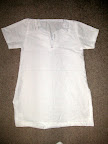


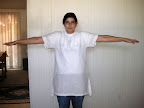

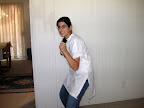
For the front of the neck hole, you’ll see two different sets of lines and fabrics in my prototype. This is because the first whole I cut I discovered was too big. When I wore the prototype the part at the bottom was at the nipple line which I felt was too low. So I cut a smaller piece of muslin and just sewed that into the inside of the prototype. So the inner line is what I’m going with. Also there is no seam allowance on the neck hole. I will not be folding in the material and sewing an edge. Instead, I will sew on a trim with a different fabric similar to the wayPikmin Link has for her tunic. I thought that was a nice touch so I’m going to try and include that in mine.
Also, this tunic is a little short. I made the mistake of buying muslin that isn’t very wide and it wasn’t wide enough to accommodate the length of the skirt. So the final has an additional 3 inches length to it with the split in the skirt 3 inches down from where it’s shown here. I may upload detailed pattern pieces at a later time.
 The Hat
The Hat
I also prototyped the hat. The old one I had made was ok but didn’t really flow well. I can’t really explain it. But it didn’t sit on my head nicely. It also had other problems with the seem so I wanted to make a lot of revisions to this pattern. Since Link’s hat inTP is a little more detailed and had a seam in it, I thought I’d use this seam to pinch out some of the fabric to make the hat fit more nicely around my head. Notice that this is one piece with one seem. You fold this piece in half and then sew along the edge making the seem at the bottom of the hat unnoticed. There’s also an additional pinch line that I’ve photoshoped into this pattern. The triangles are sections of material that are pinched together to take out material from the bottom portion of the hat to make the hat fit and drape better. The slashes are just thin pinch lines created solely for the purpose of holding the reinforcement details. You will see this in a photo of the final hat below.
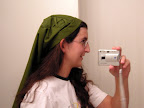

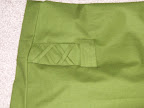
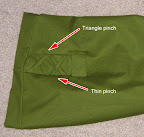
Muslin Prototype:

I made mine different from the official artwork. The official art shows only one short seam on each side of the hat. Instead I have two which is similar toPikmin Link’s design. I did this for two reasons. One I think the design just looks better, and two, by having that upper pinch it makes the shape of the hat a little more square at the top to make it fit and drape better as mentioned earlier.
This hat is pretty much done. There are only a couple things left to do. One is add the trim fabric on the rim of the hat. This will hide the ugly seems and make the hat look a little nicer. I also have not yet included the detail of the seam near the tip of the hat. I have not yet decided whether to include that or not. but its not important to me at this time. I may also make some adjustments to the fitting of it a little later.
Tunic and Hat Details
Throughout Link’s tunic and hat there are criss-cross laces or fabric to form X’s. I looked at these and wasn’t sure what they were. At first I thought they were just for pretty detail but then I started to think what their function actually was. There must be some functional reason why the artists put them there. I then thought that the ones along the side of his tunic were meant to have holes with lace going through them like the way shoes lace up to tighten the fabric. If that were the case, I would need to buy special metal pieces to hammer into the fabric to create the holes. But I didn’t see those metal rings on the illustrations. So perhaps they weren’t laces. Perhaps they are just reinforcements themselves. There is an opening of the fabric just below the armpit and I think those X’s are there to reinforce the fabric to avoid it from tearing. The opening is probably to give Link extra movement in battle. The X at the intersection of his slit also suggests that its purpose is to reinforce the fabric to keep from tearing.
I decided to take the reinforcement approach rather than the laced look, and I’m really glad I did. I saw other cosplayers on cosplayers.com take the direction of using the metal rings and lacing up the sides and it looks awful. One, it is hard to keep the fabric from bunching up in that area which makes it hard for the fabric to drape nicely. And two, the contrast in color from the metal rings and the color of the fabric makes an unnecessary distraction. I don’t want people looking at the holes. I want them looking at the overall tunic design. I noticedPikmin Link didn’t take the laced direction either (at least from what I can tell) so I wonder if perhaps she came to the same conclusion I did. Also I think doing the reinforcements is easier. I don’t want to have to deal with hammering in those metal things and worrying about what it will do to the fabric.
Of course, this doesn’t mean it isn’t possible to make the laced effect look good. I think if its done right it can look great.
Gloves, shoes, wig, etc.
I have a plan for how I will be doing the gloves which I’ll explain in a later entry. However, I’m unsure what to do about the one gauntlet strap on on the sword hand.
The shoes I’m going to do a lot of experimenting. I don’t want to do boot covers but if I run out of time I will do it as a last resort. Those things look awful. If I’m going to put THIS much detail into making my tunic and hat look good, I want everything else to be as good as possible so I’m going to attempt to make my own boots.
The wig, I’m going to experiment with as well. I purchased a long wig a while ago that I never ended up using. I will cut it and probably color it using acrylic paints. I have some fabric medium which makes the paints less glossy and softer/more flexible. Its intended for painting on fabrics but it will probably work for the wig. I’ll try it on a test piece and let you know how it goes.
For the chain mail I found an awesome video on youtube for how to make it that is low cost and fast. But this is a detail that I can afford to do without for Halloween so this is lowest on my priority list.
But for right now I’m just concentrating on getting the tunic finished. Everything else, if I don’t finish in time for Halloween I will just reuse parts from my old Link costume for Halloween and then afterwards create new, more finalized pieces and should have it done in time for Fanime.
Next
In my next entry I predict I will show how my tunic is looking and get into the gloves and pants. Stay tuned!
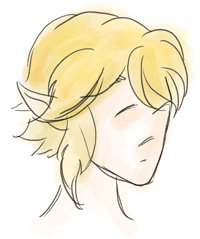 Someone recently asked me about my Link wig so I thought I’d post some details. Basically I bought a wig and made some simple modifications to it. This entry will explain the details…
Someone recently asked me about my Link wig so I thought I’d post some details. Basically I bought a wig and made some simple modifications to it. This entry will explain the details…


